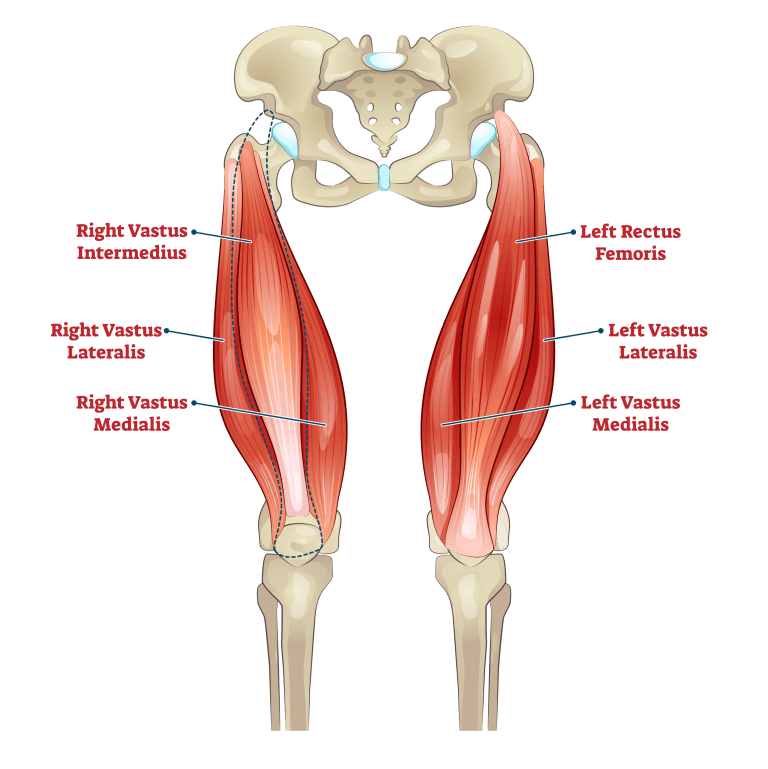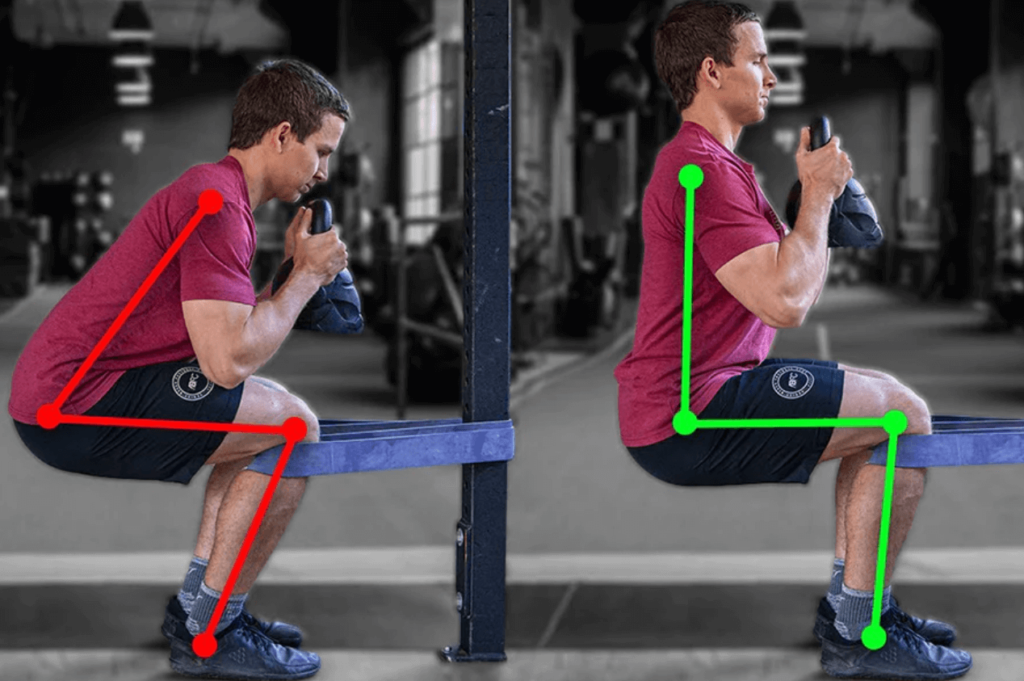When it comes to sculpting a powerful lower body, traditional exercises often dominate the scene. But amidst the familiar routines, there exists an exercise that stands out, both in name and effectiveness: The Sissy Squat. This enigmatic movement has garnered attention for its challenging nature and remarkable benefits. In this exploration, we’ll delve into the key components of the Sissy Squat, unravel its muscle engagement secrets, and offer insights into how to master this exercise for unparalleled lower body development.
Benefits and Muscle Engagement
Before diving into the specifics, let’s set the stage by understanding what the Sissy Squat truly entails. This exercise isn’t just a mere variation of squats; it’s a targeted approach to activating muscles and enhancing strength, particularly in the lower body. By deconstructing its mechanics, we can decipher the unique attributes that set it apart from conventional leg workouts.
What is a Sissy Squat?
At its core, the Sissy Squat challenges traditional notions of squatting. It’s not a mere repetition of the up-and-down movement but a nuanced engagement of muscles that often remain dormant during regular squats. Contrary to its somewhat misleading name, the term “sissy” in this context doesn’t denote weakness but rather an acknowledgement of the exercise’s demanding nature.
In debunking common misconceptions, it’s important to clarify that the Sissy Squat isn’t about choosing the easy way out; instead, it adds a twist to the familiar leg routine. This twist isn’t about sacrificing form or intensity but rather about refining your technique and embracing a novel path to leg strength and development.
Muscles Worked During Sissy Squats

Understanding the specific muscle groups targeted by the Sissy Squat sheds light on its true potential. Primarily, the exercise homes in on the quadriceps, those powerful front thigh muscles responsible for extension at the knee joint. As you lower yourself into the squat and ascend, these muscles undergo a controlled contraction that defines the essence of the Sissy Squat.
However, it’s not just the quadriceps that come into play. The core muscles, which encompass the abdominals and lower back, engage extensively to maintain stability throughout the movement. Additionally, the glutes contribute to hip extension, while the lower leg stabilizers, often overlooked in traditional squats, are intricately involved in maintaining balance and alignment.
Benefits of the Sissy Squat
So, what makes the Sissy Squat an exercise worth embracing? Let’s unlock its advantages and discover how it elevates lower body training to a whole new level. The primary allure of the Sissy Squat lies in its unparalleled quadriceps development. By focusing the effort on this muscle group, you not only build strength but also sculpt an enviable aesthetic. Your thighs become a canvas of power and definition, setting you apart in both functional fitness and visual impact.
Additionally, the Sissy Squat doubles as a knee stability enhancer. When performed with proper form, it reinforces the integrity of the knee joint, promoting healthier movement patterns and reducing the risk of injuries. Through controlled movement, you strengthen the muscles surrounding the knee, fostering a protective cocoon that supports your overall lower body function.
How To Do Sissy Squats: Step-by-Step Guide
Now that we’ve laid the groundwork, let’s delve into the intricacies of performing a Sissy Squat with finesse. Mastery of this exercise requires breaking it down into distinct steps, each contributing to the seamless execution that maximizes its benefits.
- Starting Position and Stance: To begin, stand upright with your feet hip-width apart. Maintain a proud chest and engaged core, ensuring your posture is aligned from head to toe. Position your arms either crossed in front of you or extended for balance.
- Descent Phase: Initiate the movement by leaning slightly backward while bending at the knees. Simultaneously, extend one leg forward, keeping it elevated just above the ground. Your weight should now be on the other leg.
- Ascending with Control: Begin the ascent by pushing through the heel of the grounded foot. Simultaneously, bring the elevated leg back to its original position. Throughout this movement, maintain an erect posture and engage your core for stability.
In adopting this step-by-step approach, you’ll infuse intention and precision into each phase of the Sissy Squat, transforming it from a mere exercise into an art form of muscle engagement.
Equipment Options for Sissy Squats
The beauty of the Sissy Squat lies in its versatility. It’s an exercise that doesn’t demand elaborate equipment setups. However, if you’re inclined to enhance your experience, a few options are worth exploring.
- Sissy Squat Machine: If you’re seeking stability and support, a specialized sissy squat machine could be your ally. This equipment offers a structured platform to execute the movement with a controlled form, making it ideal for beginners or those aiming to push their limits.
- Bodyweight Brilliance: On the other end of the spectrum, the Sissy Squat can be executed with nothing more than your body weight. This minimalist approach challenges your balance and control, intensifying the engagement of stabilizing muscles.
- Dumbbells and Resistance Bands: To add resistance and tailor the intensity, consider incorporating dumbbells or resistance bands. These additions elevate the Sissy Squat to a new level, promoting muscle growth and adding an element of progressive overload.
Common Mistakes to Avoid

As with any exercise, the Sissy Squat has its pitfalls that can hinder progress and increase the risk of injury. By acknowledging these common errors and understanding how to address them, you set the stage for a successful and safe Sissy Squat journey.
- Excessive Leaning: One of the primary errors is leaning too far backwards during the descent. This not only compromises the effectiveness of the exercise but also strains your lower back. To correct this, focus on maintaining an upright posture throughout the movement.
- Incorrect Foot Placement: Placing your feet too close together or too far apart can lead to instability and compromised form. Aim for a stance that mirrors your natural hip width, allowing for controlled movement and engagement of the targeted muscles.
- Rounding the Back: Allowing your back to round during the movement places undue stress on your spine and reduces the activation of your core. Counteract this by imagining a string pulling your chest upward and maintaining a proud chest throughout.
By being vigilant about these mistakes, you pave the way for a Sissy Squat experience that’s not only effective but also free from unnecessary setbacks.
Sissy Squats at Home: No Equipment Needed
Amidst the hustle and bustle of life, the convenience of home workouts cannot be understated. The Sissy Squat, fortunately, is an exercise that doesn’t require a gym membership or specialized equipment. Let’s explore a simple yet impactful home Sissy Squat routine:
- Warm-Up: Begin with a dynamic warm-up that includes leg swings, hip circles, and gentle bodyweight squats. This prepares your muscles for the upcoming challenge.
- Bodyweight Sissy Squats: Start with the basics. Perform bodyweight Sissy Squats, focusing on impeccable form and controlled movement. Aim for 3 sets of 12-15 repetitions.
- Elevated Sissy Squats: To intensify the workout, elevate your heels on a stable surface like a sturdy book or step. This added elevation increases the demand on your quadriceps and amplifies the engagement of stabilizing muscles. Complete 3 sets of 10-12 repetitions.
- Pulsing Sissy Squats: Elevate the burn with pulsing squats. Hold the lowest point of your squat for a few seconds, then pulse up and down slightly before ascending. This continuous tension intensifies muscle activation and promotes endurance. Aim for 3 sets of 10-12 pulsing reps.
- Sissy Squat Jumps: To infuse cardio into your routine, try Sissy Squat jumps. After descending into a Sissy Squat, explosively jump upwards, extending your arms overhead. Land softly and transition immediately into the next rep. Complete 3 sets of 8-10 jumps.
- Cool-Down: Wrap up your session with static stretches. Focus on your quadriceps, hamstrings, and hip flexors. These stretches aid in muscle recovery and flexibility.
By integrating these variations into your home routine, you craft a holistic Sissy Squat workout that hones strength, endurance, and mobility.
Incorporating Sissy Squats into Your Leg Day
Strategically placing Sissy Squats within your existing leg workout can yield remarkable results. By considering muscle engagement and fatigue, you’ll orchestrate a leg day that’s both efficient and effective.
- Primary Activation: Initiate your leg workout with Sissy Squats. This primes your quadriceps and core, ensuring maximum engagement during subsequent exercises.
- Superset with Complementary Moves: Pair Sissy Squats with exercises that synergize with its benefits. For instance, after a set of Sissy Squats, transition into lunges to capitalize on the activation of the quadriceps.
- Balancing the Load: Ensure that Sissy Squats aren’t the sole focus of your leg day. Include a mix of compound movements like deadlifts and lunges to engage other muscle groups and foster overall lower body development.
Sissy Squat vs. Traditional Squats
As you navigate the realm of squats, understanding the distinctions between the Sissy Squat and traditional variations is essential. Each exercise brings unique advantages to the table, catering to different fitness objectives.
Sissy Squat
Targeted Intensity: The Sissy Squat shines in its targeted focus on quadriceps development. Its controlled nature isolates this muscle group, fostering impeccable strength and definition.
Traditional Squats
Comprehensive Engagement: Traditional squats engage multiple muscle groups, including the quadriceps, hamstrings, glutes, and lower back. They offer a holistic lower body workout that contributes to overall strength and stability.
Choosing between these two isn’t about declaring one superior to the other; it’s about aligning your choice with your fitness goals and preferences.
Sample Sissy Squat Workout Routine
Empower your Sissy Squat journey with a sample workout routine that encapsulates its essence and potential.
- Warm-Up: Begin with 5 minutes of light cardio to elevate your heart rate and prepare your muscles for action.
- Sissy Squat Sets: Perform 4 sets of Sissy Squats with a moderate weight or just your body weight. Complete 10-12 repetitions per set.
- Superset with Lunges: After each Sissy Squat set, transition into lunges. Perform 3 sets of walking lunges, covering a distance of 15-20 steps per set.
- Elevated Sissy Squats: Add variety with elevated Sissy Squats. Utilize a step or platform to increase the challenge. Complete 3 sets of 8-10 repetitions.
- Cool-Down Stretches: Wind down with static stretches for your quadriceps, hamstrings, and hip flexors. Hold each stretch for 20-30 seconds.
This routine caters to various fitness levels and provides a balanced Sissy Squat experience.
How to Use a Sissy Squat Machine
While the Sissy Squat is versatile in its minimalistic execution, using a Sissy Squat machine introduces an element of structure and support. Let’s demystify the process:
- Setup: Adjust the machine to fit your height. Position yourself on the machine, ensuring the back pad rests against your lower back, and the foot platform supports your feet.
- Execution: Hold onto the handles for stability. As you descend, allow the knee pads to support your legs. Keep your posture upright and engage your core.
- Ascending: Push through your heels and ascend. Focus on controlled movement, utilizing the machine’s mechanics for a smooth workout.
Using a Sissy Squat machine amplifies your experience by ensuring proper form and controlled movement.
Conclusion
In this journey through the intricacies of the Sissy Squat, we’ve uncovered its mystique and potential. It’s not just an exercise; it’s a testament to targeted muscle engagement, strength development, and meticulous form. By embracing the challenge of the Sissy Squat, you embark on a path that celebrates progress and cultivates lower body prowess. Remember, results are born from dedication, patience, and consistency. As you integrate the Sissy Squat into your fitness regimen, let its uniqueness fuel your determination, and let its benefits redefine your lower body journey.
FAQs About Sissy Squat
As you delve into the world of Sissy Squats, questions might arise. Here, we address some of the most common inquiries to provide you with a comprehensive understanding of this unique exercise.
What is the origin of the term “Sissy Squat”?
Despite its name, the term “Sissy Squat” doesn’t imply weakness. It’s derived from the exercise’s inventor, professional wrestler Joey “Sissy” Smith, who pioneered this movement. The name has endured over time, even though the exercise itself is far from easy.
Are Sissy Squats suitable for beginners?
Yes, Sissy Squats can be adapted for various fitness levels. Beginners can start with bodyweight Sissy Squats and gradually progress to include weights or variations as they become more comfortable and confident with the movement.
Can Sissy Squats replace traditional squats in my workout routine?
While Sissy Squats offer unique benefits, they shouldn’t entirely replace traditional squats. Both exercises engage different muscle groups and serve distinct purposes. It’s recommended to include a variety of squat variations to ensure comprehensive lower body development.
Do I need a Sissy Squat machine to perform the exercise?
No, a Sissy Squat machine is not a necessity. While the machine provides stability and support, you can perform Sissy Squats using just your body weight or minimal equipment like dumbbells or resistance bands. The choice depends on your preference and fitness goals.
Can Sissy Squats cause knee pain?
When performed with proper form, Sissy Squats can actually help improve knee stability and mobility. However, incorrect technique, excessive leaning, or overloading the exercise can lead to knee discomfort. Prioritize maintaining proper form and avoid progressing too quickly to prevent unnecessary strain.
How often should I include Sissy Squats in my workout routine?
The frequency of Sissy Squats depends on your overall workout plan and fitness goals. As a general guideline, aim to include them 1-2 times a week, ensuring sufficient rest and recovery between sessions.
Can Sissy Squats be part of a leg day routine?
Absolutely. Sissy Squats can be a valuable addition to your leg day routine. Consider incorporating them as a primary movement or superset them with other leg exercises to maximize muscle engagement.




